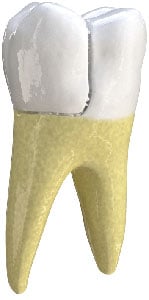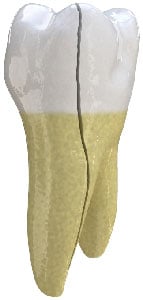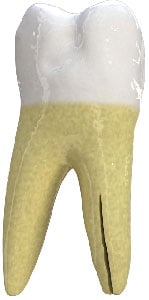Fractures or cracks can occur rapidly or slowly over a period of time. This can be painless for the patient or can cause severe discomfort. Determining the location and severity of the crack will determine the course of action for the tooth, although many cracks can be treated with conventional root canal therapy. Endodontists are specialists at diagnosing your symptoms and saving your teeth! Dr. Habas can help you fix your cracked tooth!
How Do I Know If My Tooth Is Cracked?
Cracked teeth have a variety of symptoms and can be difficult to diagnose. Often, patients experience an erratic pain when chewing, possibly with release of biting pressure, or pain when the tooth is exposed to extreme temperatures. The pain may often come and go with no apparent trigger. Cracks most often appear in the posterior, or back teeth, and cannot heal on their own.
How Can I Prevent My Teeth From Cracking?
While cracked teeth are not completely preventable, there are a few precautionary measures you can take:
- Don’t chew on hard objects such as ice, unpopped popcorn kernels, or pens
- Don’t grind or clench your teeth
- If you grind or clench at night, talk to Dr. Habas about a night guard
- Wear a mouthguard when playing contact sports
Types of Cracks
Craze Lines
These are small fissures on the surface of your tooth that affect only the enamel. Craze lines are usually not serious and only affect the appearance of the tooth’s surface.
Fractured Cusp
This type of crack occurs when a portion of the tooth’s cusp splits or breaks off entirely. Fractured cusps do not typically affect the tooth’s root, so the damage can usually be repaired with a full crown. Dr. Habas may remove the damaged part of the cusp if it has not already broken off.

Cracked Tooth
A cracked tooth is an incomplete fracture that affects the chewing surface of the tooth and may extend down to the gum line and even to the root. It is essential to detect these types of cracks early so that further damage can be prevented. Treatment will depend on the extensiveness of the crack, but a root canal procedure is often needed to restore the tooth.

Split Tooth
If a cracked tooth is left untreated, it can progress to a split tooth. A split tooth involves a complete fracture from the crown down through the root. In this case, the tooth’s dentin has separated into two distinct sections. Often, this condition progresses from a cracked tooth over time. If the fracture is severe enough, the tooth will need to be extracted. However, in some cases a segment of the tooth can be removed and the remaining portion can be salvaged by an endodontist.

Vertical Root Fracture
This type of fracture starts at the root of the tooth and extends toward the crown. Typically, the patient will not experience symptoms until the fracture becomes severe. Treatment often requires extraction, but in some cases a portion of the tooth can be saved with endodontic surgery.
